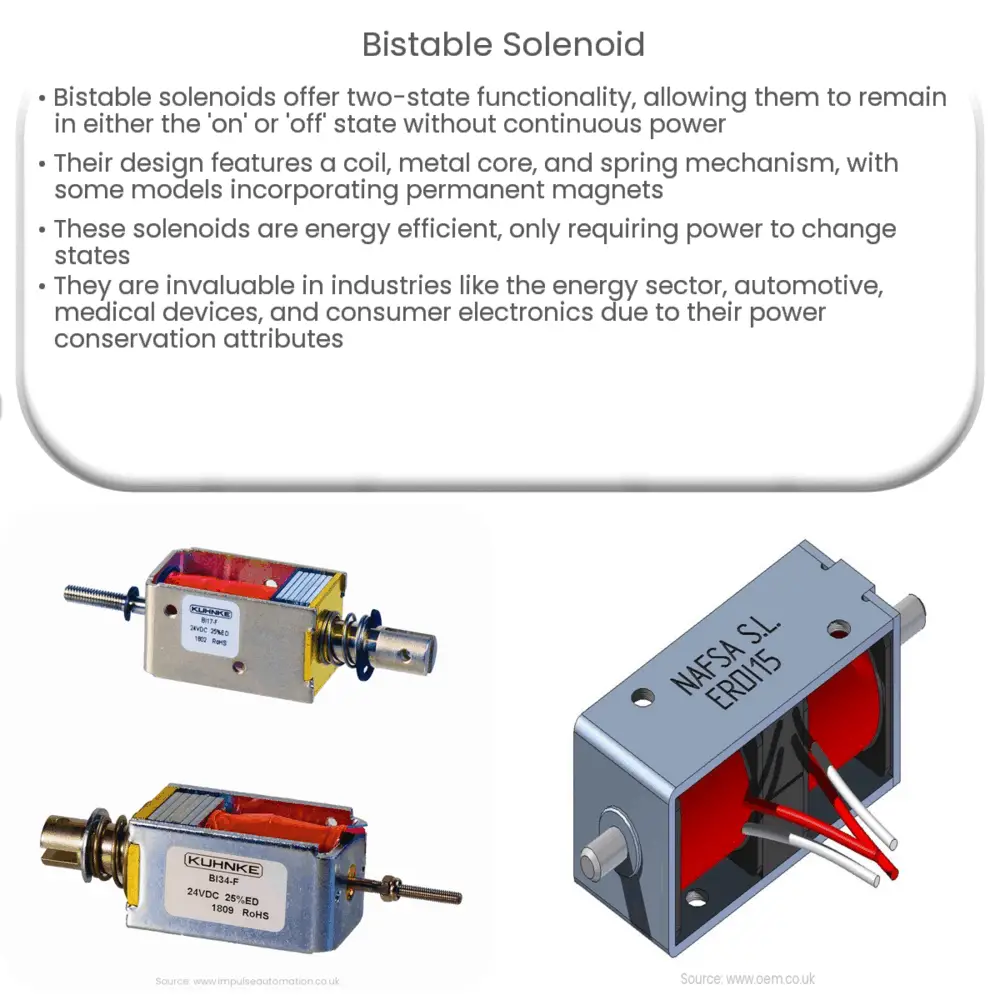A bistable solenoid is an energy-efficient electromagnetic device that can hold two states (‘on’ or ‘off’) without continuous electrical power.

Introduction to Bistable Solenoids
Bistable solenoids are a specific type of electromagnetic device that provides unique utility in various applications due to their bistable, or two-state, functionality. The term ‘bistable’ refers to the device’s ability to remain in either of its two positions (energized or de-energized) without the need for continuous electrical power.
At their core, bistable solenoids consist of a coil of wire, a metal core, and a spring mechanism. When the coil is energized with an electrical current, a magnetic field is produced, pulling the metal core into the coil and changing the position of the device. This is the ‘on’ state. When the current is removed, instead of reverting back to the original position like a monostable solenoid, a bistable solenoid stays in the ‘on’ state due to the additional spring mechanism. The solenoid will only return to its original state when a reverse current is applied, triggering the ‘off’ state.
Principle of Operation
The operation of a bistable solenoid is rooted in electromagnetic principles. When an electrical current is passed through the coil, it creates a magnetic field that attracts the metal core into the coil, shifting the device to the ‘on’ state. The force of the magnetic field is counterbalanced by a spring mechanism, which holds the core in place once the current is removed.
However, unlike a monostable solenoid that requires continuous power to maintain the ‘on’ state, a bistable solenoid requires power only to change states. This happens when a reverse polarity current is applied to the coil, creating a reverse magnetic field that forces the core back to its original position against the spring mechanism.
This operational characteristic makes bistable solenoids particularly energy efficient, as they do not need a continuous power supply to maintain either state. This feature has made them highly desirable in applications where power supply may be intermittent or where energy efficiency is of paramount importance.
The distinct functionality of bistable solenoids is attributable to their unique design. The next part of this article will further explore the design elements that enable this bistability and delve into the various applications that take advantage of this characteristic.
Key Design Elements of Bistable Solenoids
There are several key design elements in a bistable solenoid that allow for its unique functionality. One of the most important is the spring mechanism. In a bistable solenoid, a specially designed spring holds the core in its ‘on’ or ‘off’ state even when the power is turned off.
Another design feature contributing to bistability is the use of permanent magnets. Some bistable solenoids incorporate a permanent magnet into the design, which aids in maintaining the solenoid’s state without the need for constant electrical input.
The coil in a bistable solenoid is designed to accept current in two directions. When current is passed in one direction, the solenoid shifts to the ‘on’ state. When current is passed in the opposite direction, the solenoid switches to the ‘off’ state.
Applications of Bistable Solenoids
Bistable solenoids have wide-ranging applications across several industries due to their energy efficiency and ability to hold two states without continuous power. Here are a few notable examples:
Energy sector: Bistable solenoids are commonly used in smart meters and circuit breakers. Their bistability allows them to maintain the ‘on’ or ‘off’ state, thereby conserving power.
Automotive industry: Bistable solenoids are used in car door locks and power windows due to their ability to remain in a given state without consuming power, thus conserving the vehicle’s battery life.
Medical Devices: In devices like automatic defibrillators and drug delivery systems, the bistability of these solenoids ensures that the device maintains its state even when not actively in use, conserving battery life.
Consumer Electronics: In devices such as smartphones and tablets, bistable solenoids can be used in physical buttons to maintain the button’s state without draining the device’s battery.
In conclusion, bistable solenoids, with their unique design and energy-efficient operation, have become a crucial component in various applications across different industries. Their ability to maintain a state without continuous power input makes them an invaluable tool in today’s power-conscious world.

